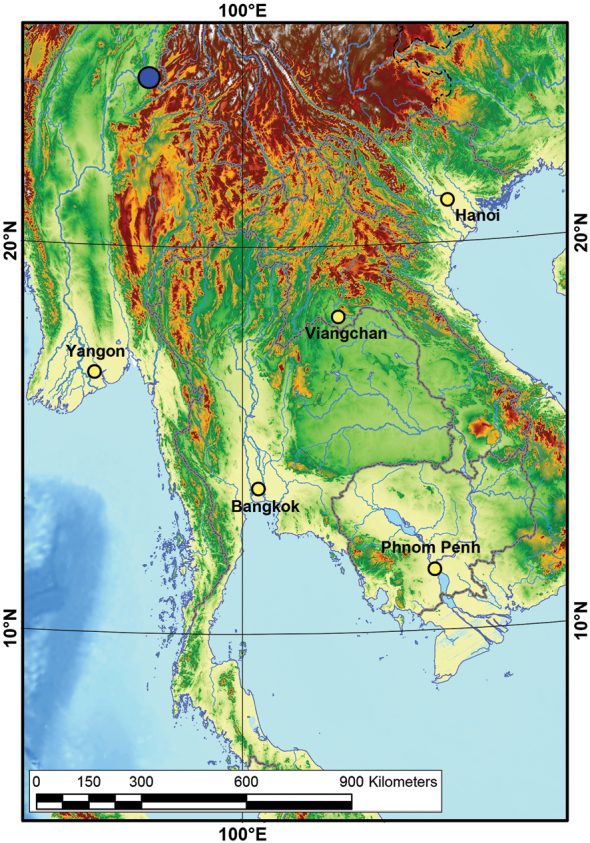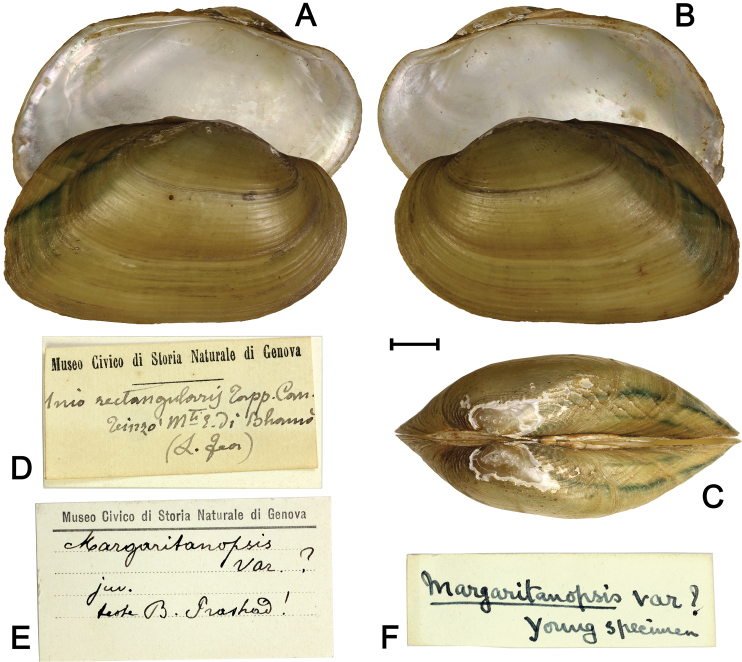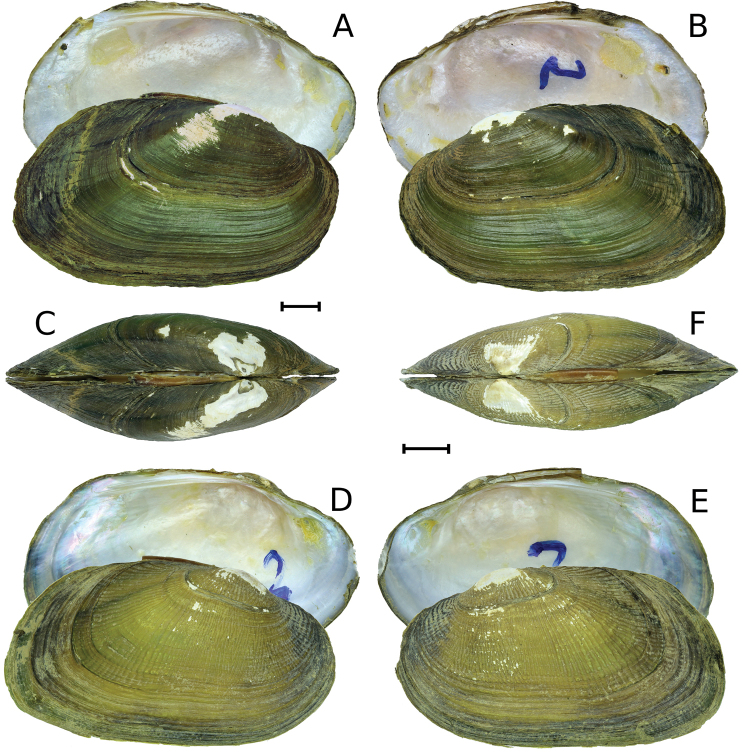Abstract
Uniorectangularis Tapparone-Canefri, 1889 is a little-known nominal species of freshwater mussels described from a tributary of the Ayeyarwady River in Myanmar. This taxon was considered a synonym of Gibbosulalaosensis (Lea, 1863), a margaritiferid species. However, the range of Gibbosulalaosensis does not encompass the Ayeyarwady River watershed. Here we re-examine the holotype of Uniorectangularis and provide a conchological re-description of this species. Based on conchological features such as the shell shape, elevated umbo, and the structure of lateral and pseudocardinal teeth, we transfer this taxon to the genus Indonaia Prashad, 1918 and propose I.rectangularis (Tapparone-Canefri, 1889), comb. nov. It appears to be a rare freshwater mussel species with a restricted range, because it has not been found since the original description. Two additional species in this genus are known from Myanmar, i.e. Indonaiaandersoniana (Nevill, 1877) and I.subclathrata (Martens, 1899).
Keywords: Ayeyarwady River, Indochinellini, Margaritiferidae, Parreysiinae, Southeast Asia, Unionidae
Introduction
Gibbosulalaosensis (Lea, 1863) (Bivalvia, Margaritiferidae) is an endangered freshwater mussel species from Southeast Asia (Bolotov et al. 2014), which has recently been transferred from Margaritifera Schumacher, 1816 to Gibbosula Simpson, 1900 (Lopes-Lima et al. 2018). Several enigmatic nominal taxa and nomina dubia were linked to this species as its putative synonyms or closely related species, i.e. Uniorectangularis Tapparone-Canefri, 1889, U.sula Simpson, 1900, U.sella Haas, 1912, and Margaritanopsiswoodthorpi Godwin-Austen, 1919 (Simpson 1900; Haas 1912; Godwin-Austen 1919; Prashad 1922). While the complete story of the three latter names remains to be discussed, a taxonomic reassignment of Uniorectangularis is presented here.
Leonardo Fea, an adventurous Italian pioneer and explorer, found a single shell of Uniorectangularis among large collections of non-marine molluscs from British Burma during his travels in 1885–1887 (Tapparone-Canefri 1889; Prashad 1922). Cesare Maria Tapparone-Canefri, a famous Italian malacologist, studied this sample and published a comprehensive paper (Tapparone-Canefri 1889) with a description of numerous new taxa of terrestrial and freshwater molluscs, including Uniorectangularis.
Later, Prashad (1922) revisited Tapparone-Canefri’s unionid taxa in his broad-scale review of freshwater mussels described from British Burma. In the account on Gibbosulalaosensis, Prashad (1922: 93) stated that: “The species described as Uniorectangularis by Tapparone-Canefri [...] is based on a single very young shell. It is undoubtedly to be referred to the genus Margaritanopsis and probably represents another species of the genus. Owing, however, to a single young shell being available I do not feel disposed to consider it as a distinct species…”. After that generic reassignment of Uniorectangularis, this species was completely forgotten, lost to malacological taxonomy, and it was not listed in the subsequent taxonomic checklists on freshwater mussels of the Oriental Region (Brandt 1974; Subba-Rao 1989; Bolotov et al. 2017a; Zieritz et al. 2018) and in the most authoritative global revisions (Haas 1969; Graf and Cummings 2007).
We revise the generic placement of Uniorectangularis and discuss its prospective taxonomic status based on morphological study of the type specimen.
Material and methods
We studied the holotype of Uniorectangularis in the Museo Civico di Storia Naturale di Genovay (MSNG), Genova, Italy. The images of the specimen were taken with Canon EOS 7D DSLR camera (Canon Inc., Japan). Shell measurements were performed with Adobe Photoshop CS using digital photographs of the holotype. Samples of Indonaiaandersoniana (Nevill, 1877) (N = 37 specimens) and I.subclathrata (Martens, 1899) (N = 7 specimens) were studied in the Russian Museum of Biodiversity Hotspots (RMBH), Federal Center for Integrated Arctic Research of the Russian Academy of Sciences, Arkhangelsk, Russia. Three shell dimensions at each specimen of the studied taxa (length, height, and width of the shell, all taken at the maximum diameter) were measured using calipers (±0.1 mm). The comparative analysis of shell morphology was carried out with regard to the main distinguishing traits, such as shell shape, umbo position, structures of pseudocardinal and lateral teeth, as well as muscle attachment scars (Konopleva et al. 2019).
Results
Family Unionidae Rafinesque, 1820
Subfamily Parreysiinae Henderson, 1935
Tribe Indochinellini Bolotov, Pfeiffer, Vikhrev & Konopleva, 2018
Genus Indonaia Prashad, 1918
Indonaia rectangularis
(Tapparone-Canefri, 1889) comb. nov.
Figure 1.
Holotype of Indonaiarectangularis (Tapparone-Canefri, 1889), comb. nov. [MSNG]. A, B Shell, lateral view: inner side of the left valve and outer side of the right valve (A); vice versa (B) C shell, dorsal view D original label [probably by C.M. Tapparone-Canefri] E, F secondary labels [probably by B. Prashad]. Scale bar: 5 mm. (Photos: Ilya V. Vikhrev).
=UniorectangularisTapparone-Canefri 1889: 354.
=Margaritanopsisrectangularis (Tapparone-Canefri, 1889). – Prashad 1922: 93, pl. 2, fig. 5.
Type.
Holotype in MSNG, without ID number (Fig. 1A–C). Original label: “Uniorectangularis Tapp. Can. Teinzo, Mti E. di Bhamo (L. Fea)” (Fig. 1D). Secondary labels: “Margaritanopsis var.? juv. detto B. Prashad!” (Fig. 1E) and “Margaritanopsis var.? Young specimen” (Fig. 1F). The original label does not have a collecting date, but Fea’s sample of another freshwater mussel species from Teinzo residing in the MSNG is dated “Marzo 1886” that may also be applicable to the holotype of U.rectangularis.
Type locality.
Teinzo (presently Teinthaw village), 24.3978N, 97.2519E, Moolay River (Mole Chaung in Burmese), hills E of Bhamo (L. Fea), alt. 110 m a.s.l., Ayeyarwady Basin, Myanmar (Tapparone-Canefri 1889).
Diagnosis.
As Tapparone-Canefri (1889) stated, the shell of Indonaiarectangularis is not similar to any other freshwater mussel species known from Myanmar. This species cannot be mistaken with the two congeners, Indonaiaandersoniana and I.subclathrata (Fig. 2), that were described from the Ayeyarwady Basin. Both these species differ from Indonaiarectangularis by a more elongated shell and less developed lateral, and pseudocardinal teeth. The pseudocardinal teeth in I.rectangularis are lamellar, thick, and very elongated. Additionally, a unique feature of I.rectangularis is the presence of regular ridges crossing the growth lines in the posterior-dorsal area forming a clear rectangular pattern that was never seen in other species (Fig. 1C).
Figure 2.
Specimens of Indonaiaandersoniana (Nevill, 1877) and I.subclathrata (Martens, 1899) from Myanmar [RMBH biv450_2 and RMBH biv347_2, respectively]. A, B Shell of I.andersoniana, lateral view: inner side of the left valve and outer side of the right valve (A); vice versa (B) C shell of I.andersoniana, dorsal view D, E shell of I.subclathrata, lateral view: inner side of the left valve and outer side of the right valve (D); vice versa (E) F shell of I.subclathrata, dorsal view. Scale bar: 5 mm. (Photos: Ekaterina S. Konopleva).
Redescription.
Shell length 34.2 mm, height 20.4 mm, width 16.2 mm. Shell thick, obovate, inequilateral, with broader posterior side. Dorsal margin slightly convex. Ventral margin nearly straight. Anterior margin rounded. Posterior margin slightly elevated posteriorly, with an inconspicuous wing. Umbo prominent, elevated, rounded, slightly eroded. Shell surface mostly smooth. In the posterior-dorsal area, regular ridges cross the growth lines and form a clear rectangular pattern. In the anterior-dorsal area, curved, lamella-like ridges closely spaced along growth lines. Periostracum light olive-brown, with two parallel, slightly curved green bands along posterior-dorsal area; inner band with a broad greenish extension posteriorly. Nacre silver-white. Umbo cavity deep. Anterior adductor scar round, shallow but well marked. Posterior adductor scar oval, very shallow, unclear. Mantle attachment scars absent. Pseudocardinal teeth are thick, lamella-like, very elongated, two teeth in the right valve and one tooth in the left valve. Lateral teeth well developed, thick, elongated and straight, one tooth in the right valve and two teeth in the left valve. Soft body morphology and anatomy unknown.
Remarks.
Uniorectangularis was originally described based on a single specimen with a shell 34.2 mm long, 20 mm high and 16 mm wide (Tapparone-Canefri 1889). The single shell labelled as Uniorectangularis and deposited in the MSNG studied here corresponds in dimensions to the specimen described by Tapparone-Canefri. The original label (Fig. 1D) also affirms that this shell is the holotype of Uniorectangularis designated by monotypy.
Distribution.
This species is known only from the type locality, a tributary of the Ayeyarwady River (Fig. 3). It appears to be a rather restricted and rare species, because it has not been recorded since the original description, even during a recent broad-scale survey of freshwater mussels in Myanmar (Bolotov et al. 2017a, b, 2018; Konopleva et al. 2019). However, there has been no studies on freshwater mussels from the Mole River published since Tapparone-Canefri (1889).
Figure 3.

Map of the type locality of Indonaiarectangularis (Tapparone-Canefri, 1889), comb. nov. (dark blue circle). The digital elevation model and other layers of the map were added from the Esri Data & Maps 10 dataset.
Discussion
The results of our study reveal that Uniorectangularis is not a margaritiferid because it does not have mantle attachment scars, the most prominent diagnostic feature of the Margaritiferidae (Lopes-Lima et al. 2018). Uniorectangularis can be placed within the genus Indonaia based on conchological features, i.e. the shell shape, elevated umbo, and the structure of lateral and pseudocardinal teeth (Figs 1, 2). Prashad (1922) considered that the holotype of Uniorectangularis is a “very young shell”. However, all Indonaia species are rather small mussels (Fig. 2), and this holotype shell surely represents an adult specimen.
Indonaia represents the most divergent phylogenetic clade among the tribe Indochinellini (Bolotov et al. 2017a, 2018; Pfeiffer et al. 2018; Konopleva et al. 2019). This genus contains three species from India and three species from Myanmar (Konopleva et al. 2019). The taxonomic relationship of Indonaia with another Oriental genus, Radiatula Simpson, 1900, is still to be resolved, because molecular sequences of Uniocrispisulcatus Benson, 1862, the type species of Radiatula, are still not available.
Key to species of Indonaia from Myanmar
| 1 | Shell surface with radial ridges covering the entire shell disc | I.subclathrata (Martens, 1899)* |
| – | Shell surface without radial ridges on the shell disc | 2 |
| 2 | Shell surface mostly smooth, while regular ridges cross the growth lines and form a clear rectangular pattern in the posterior-dorsal area, and curved, lamella-like ridges closely spaced along growth lines in the anterior-dorsal area | I.rectangularis (Tapparone-Canefri, 1889), comb. nov.** |
| – | Shell surface smooth | I.andersoniana (Nevill, 1877)*** |
Supplementary Material
Acknowledgements
This work was partly funded by grants from the Russian Ministry of Education and Science (Project No. 6.2343.2017/4.6), Federal Agency for Scientific Organizations (Project No. AAAA-A18-118012390161-9), National Geographic Society (Project No. NGS-274R-18), Russian Foundation for Basic Research (Project Nos. 16-34-00638 and 18-34-20033), and Northern Arctic Federal University. Fundação para a Ciência e a Tecnologia – FCT supported MLL under grant No. SFRH/BD/115728/2016. We thank Maria Tavano, curator of the invertebrate collection of MSNG (Genova, Italy), for her great help during work with Tapparone-Canefri’s collection. Dirk van Damme and Daniel Graf greatly helped us to improve an earlier version of the paper.
Citation
Bolotov IN, Vikhrev IV, Lopes-Lima M, Gofarov MY, Konopleva ES, Lunn Z, Chan N, Bogan AE (2019) Indonaia rectangularis (Tapparone-Canefri, 1889) comb. nov., a forgotten freshwater mussel species from Myanmar (Bivalvia, Unionidae). ZooKeys 852: 23–30. https://doi.org/10.3897/zookeys.852.33898
Footnotes
Manipur, Chindwin rivers, middle reaches of the Ayeyarwady River; common species (Konopleva et al. 2019)
Mole River, Ayeyarwady Basin; rare species
Middle reaches and downstream of the Ayeyarwady River; common species (Bolotov et al. 2017a, 2018; Konopleva et al. 2019)
References
- Bolotov I, Vikhrev I, Bespalaya Y, Artamonova V, Gofarov M, Kolosova J, Kondakov A, Makhrov A, Frolov A, Tumpeesuwan S, Lyubas A, Romanis T, Titova K. (2014) Ecology and conservation of the endangered Indochinese freshwater pearl mussel, Margaritiferalaosensis (Lea, 1863) in the Nam Pe and Nam Long rivers, northern Laos. Tropical Conservation Science 7(4): 706–719. 10.1177/194008291400700409 [DOI] [Google Scholar]
- Bolotov IN, Vikhrev IV, Kondakov AV, Konopleva ES, Gofarov MY, Aksenova OV, Tumpeesuwan S. (2017a) New taxa of freshwater mussels (Unionidae) from a species-rich but overlooked evolutionary hotspot in Southeast Asia. Scientific Reports 7: 1–18. 10.1038/s41598-017-11957-9 [DOI] [PMC free article] [PubMed] [Google Scholar]
- Bolotov IN, Kondakov AV, Vikhrev IV, Aksenova OV, Bespalaya YV, Gofarov MY, Kolosova YS, Konopleva ES, Spitsyn VM, Tanmuangpak K, Tumpeesuwan S. (2017b) Ancient river inference explains exceptional Oriental freshwater mussel radiations. Scientific Reports 7: 1–14. 10.1038/s41598-017-02312-z [DOI] [PMC free article] [PubMed] [Google Scholar]
- Bolotov IN, Pfeiffer J, Konopleva ES, Vikhrev IV, Kondakov AV, Aksenova OV, Gofarov MY, Tumpeesuwan S, Than Win. (2018) A new genus and tribe of freshwater mussel (Unionidae) from Southeast Asia. Scientific Reports 8: 1–12. 10.1038/s41598-018-28385-y [DOI] [PMC free article] [PubMed] [Google Scholar]
- Brandt RAM. (1974) The non-marine aquatic Mollusca of Thailand. Archiv für Molluskenkunde 105: 1–423. [Google Scholar]
- Godwin-Austen HH. (1919) Description of a new species of Margaritanopsis (Unionidae) from the southern Shan States, with notes on Solenaiasoleniformis. Records of the Indian Museum 16: 203–205. 10.5962/bhl.part.25931 [DOI] [Google Scholar]
- Graf DL, Cummings KS. (2007) Review of the systematics and global diversity of freshwater mussel species (Bivalvia: Unionoida). Journal of Molluscan Studies 73: 291–314. 10.1093/mollus/eym029 [DOI] [Google Scholar]
- Haas F. (1912) Die Unioniden. In: Küster HC. (Ed.) Systematisches Conchylien-Cabinet von Martini und Chemnitz (Bd.9, Abt. 2, H. 46), 113–136. [pls 30–35]
- Haas F. (1969) Superfamilia Unionacea. Das Tierreich 88: 1–663. [Google Scholar]
- Konopleva ES, Pfeiffer JM, Vikhrev IV, Kondakov AV, Gofarov MY, Aksenova OV, Zau Lunn, Nyein Chan, Bolotov IN. (2019) A new genus and two new species of freshwater mussels (Unionidae) from western Indochina. Scientific Reports 9: 1–14. 10.1038/s41598-019-39365-1 [DOI] [PMC free article] [PubMed] [Google Scholar]
- Lopes-Lima M, Bolotov IN, Aldridge DC, Fonseca MM, Gan HM, Gofarov MY, Kondakov AV, Prié V, Sousa R, Varandas S, Vikhrev IV, Teixeira A, Wu R-W, Wu X, Zieritz A, Froufe E, Bogan AE. (2018) Expansion and systematics redefinition of the most threatened freshwater mussel family, the Margaritiferidae. Molecular Phylogenetics and Evolution 127: 98–118. 10.1016/j.ympev.2018.04.041 [DOI] [PubMed] [Google Scholar]
- Pfeiffer JM, Graf DL, Cummings KS, Page LM. (2018) Molecular phylogeny and taxonomic revision of two enigmatic freshwater mussel genera (Bivalvia: Unionidaeincertae sedis: Harmandia and Unionetta) reveals a diverse clade of Southeast Asian Parreysiinae. Journal of Molluscan Studies 84(4): 404–416. 10.1093/mollus/eyy028 [DOI] [Google Scholar]
- Prashad B. (1922) A revision of the Burmese Unionidae. Records of the Indian Museum 24: 91–111. [Google Scholar]
- Simpson CT. (1900) Synopsis of the naiades, or pearly fresh-water mussels. Proceedings of the United States National Museum 22: 501–1044. 10.5479/si.00963801.22-1205.501 [DOI] [Google Scholar]
- Subba Rao NV. (1989) Handbook of freshwater molluscs of India. Zoological Survey of India, Calcutta, 289 pp. [Google Scholar]
- Tapparone-Canefri C. (1889) Viaggio de Leonardo Fea in Birmania e regioni vicine. XVIII. Molluschi terrestri e d’acqua dolce. Annali del Museo Civico di Storia Naturale de Genova 27: 295–359. [Google Scholar]
- Zieritz A, Bogan AE, Froufe E, Klishko O, Kondo T, Kovitvadhi U, Kovitvadhi S, Lee JH, Lopes-Lima M, Pfeiffer JM, Sousa R, Do VT, Vikhrev I, Zanatta DT. (2018) Diversity, biogeography and conservation of freshwater mussels (Bivalvia: Unionida) in East and Southeast Asia. Hydrobiologia 810(1): 29–44. 10.1007/s10750-017-3104-8 [DOI] [Google Scholar]
Associated Data
This section collects any data citations, data availability statements, or supplementary materials included in this article.




